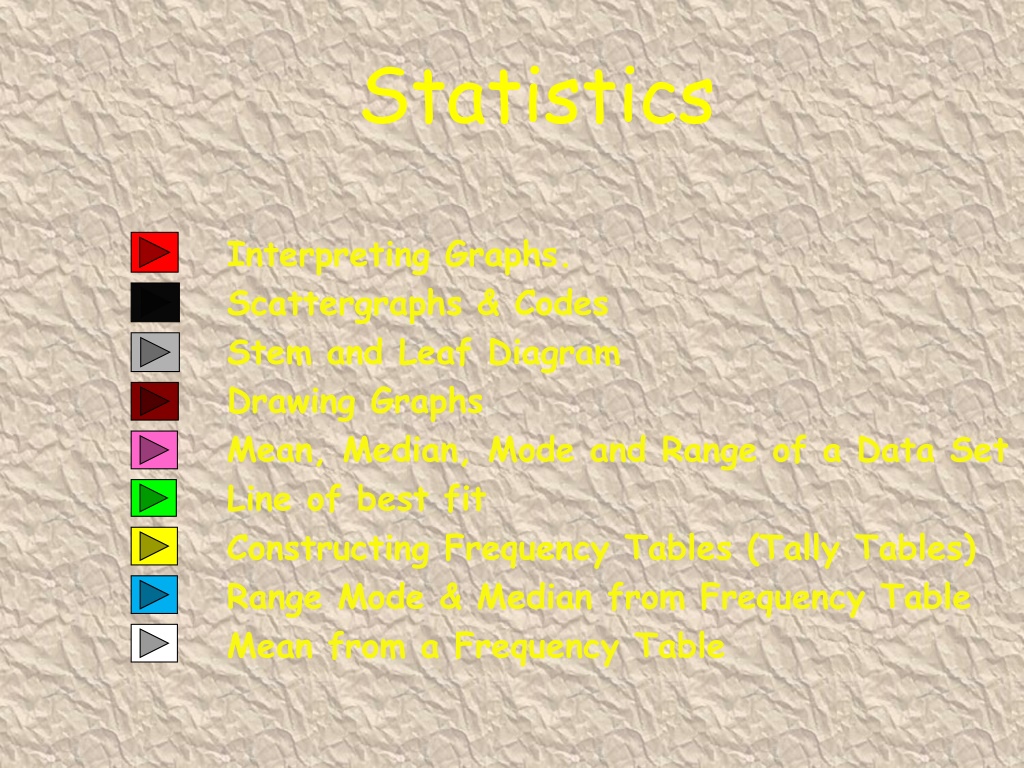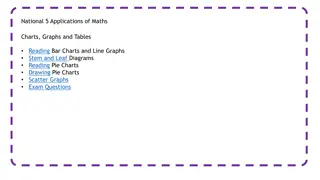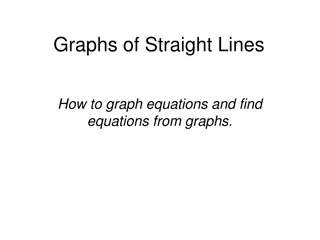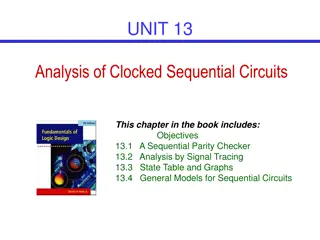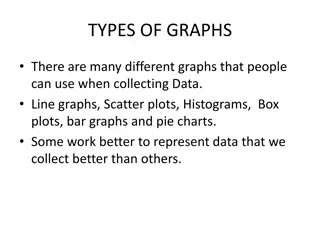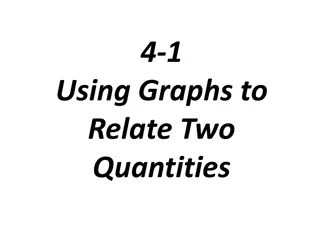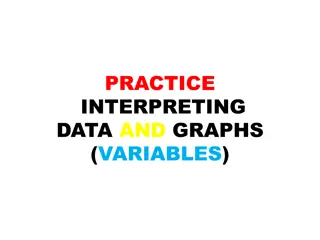Statistics: Interpreting Graphs and Constructing Tables
Diving into statistics, this content covers interpreting graphs like scattergraphs and creating frequency tables. It explains concepts such as mean, median, mode, and range, along with constructing various graphs accurately. Learn to draw stem-and-leaf diagrams, analyze line graphs, and more.
Download Presentation

Please find below an Image/Link to download the presentation.
The content on the website is provided AS IS for your information and personal use only. It may not be sold, licensed, or shared on other websites without obtaining consent from the author.If you encounter any issues during the download, it is possible that the publisher has removed the file from their server.
You are allowed to download the files provided on this website for personal or commercial use, subject to the condition that they are used lawfully. All files are the property of their respective owners.
The content on the website is provided AS IS for your information and personal use only. It may not be sold, licensed, or shared on other websites without obtaining consent from the author.
E N D
Presentation Transcript
Statistics Interpreting Graphs. Scattergraphs & Codes Stem and Leaf Diagram Drawing Graphs Mean, Median, Mode and Range of a Data Set Line of best fit Constructing Frequency Tables (Tally Tables) Range Mode & Median from Frequency Table Mean from a Frequency Table
Interpreting Graphs Learning Intention Success Criteria 1. To explain how to interpret various graphs. 1. Understand key information on various graphs. 2. Solve problems involving graphs.
You have 1 minute to come up with a What does 1 computer represent question Interpreting Graphs
Interpreting Graphs General Created by Mr.Lafferty Maths Dept
Drawing Pie Charts Favourite Sport In a survey, 300 people were asked to indicate which one of five sports they liked best. Using the graph calculate the number people who liked each sport. Rugby Football Cricket Ice Hockey Squash 75 90 45 60 30 Total 300 90 360 = Rugby angle = x 30 0 7 5 108 360 = Football angle = x 30 0 9 0 90o 108o 54 360 36o = Cricket angle = x 30 0 4 5 54o72o 72 36 = Ice Hockey angle = x 3 00 6 0 0 36 360 = Squash angle = x 30 0 3 0
Constructing Graphs Learning Intention Success Criteria 1. Understand how to construct various graphs from given 1. To construct various graphs accurately. information.
Bar Graphs A survey of S1 pupils asked what their favourite pet was. The results are shown below Lets construct a Bar graph for the following table Remember graph has to be labelled and neat !
Favourite Pets What labels should we use for the Bar Chart 12 Title, Scale, Labels and Units where appropriate 10 Number of Pupils 8 6 4 2 0 Cat Dog Rabbit Hamster Snake Pets
Line graphs Line graphs are most often used to show trends over time. If the temperature in Aberdeen, in C, over a 12-hour period is plotted, the line graph shows the temperature trend. Temperature in Aberdeen 16 14 Temperature ( C) 12 10 8 6 4 2 0 6 am 7 am 8 am 9 am 10 am 11 am 12 pm 1 pm 2 pm 3 pm 4 pm 5 pm 6 pm Time 10
Constructing a Line Graph A hospital nurse recorded a patient s temperature every hour Time Temp 6am 101 7am 102 8am 102 9am 101 10am 100.5 11am 101 Temperature versus Time 103 102 Temperature F 101 100 99 98 97 6:00 am 7:00 am 8:00 am 9:00 am 10:00 am 11:00 am 101 102 102 101 100.5 101 Temp C Time Hours 11
Different Averages Learning Intention Success Criteria 1. To define the terms Mean Median, Mode and Range for a set of data. 1. Know the terms Mean, Median, Mode and Range. 2. Work out values of Mean, Median, Mode and Range.
Mean (Average) Sum of all the data values The Mean = how many data values Find the mean of the set of data 1, 1, 1, 1, 2, 3, 26 1+1+1+1+2+3+26 7 The Mean = =5 Can you see that this is not the most suitable of averages since five out of the six numbers are all below the mean of 5
Different Averages An average should indicate a measure of central tendency but should also indicate what the distribution of data looks like. This is why we have 3 different types of averages to consider 1. The Mean 2. The Median (put the data in order then find the MIDDLE value) 3. The Mode (the number that appears the most) For the above data the Median or Mode is a better average = 1
Different Averages Example : Find the mean, median, mode and range for the set of data. Range = Highest number Lowest Number 10, 2, 14, 1, 14, 7 48 Mean = =8 6 Mode =14 Range =14-1 =13 Median =1,2, 7,10 4,14 ,1 7 +10 2 17 2 Median = = =8.5
Aims of the Lesson 1. Understand the term Frequency Table. 2. Construct a Frequency Table. 3. Interpret information from Frequency Tables. 16
Frequency tables Raw data can often appear untidy and difficult to understand. Organising such data into frequency tables can make it much easier to make sense of (interpret) the data. Data Tally Frequency llll represents a tally of 5 Sum of Tally is the Frequency 17
Frequency tables Example1. A tomato grower ideally wants his tomatoes to have diameters of 60mm, but a diameter ranging from 58mm to 62mm will be acceptable. Organise the diameters given below into a frequency table. 58 56 59 57 60 56 62 62 58 56 58 59 56 59 56 59 57 58 60 62 61 58 59 62 60 58 60 59 56 59 60 61 56 60 62 59 61 58 60 61 62 58 57 62 59 61 58 60 Lowest number 56 Highest number 62 18
Frequency tables X X 59 X 57 X 60 X 56 X 58 56 62 60 58 60 58 59 57 59 56 59 57 58 60 59 61 58 59 62 60 58 60 59 59 60 59 61 59 60 62 59 61 58 60 61 59 58 57 62 59 61 58 60 Diameter 56 57 58 59 60 61 62 Tally l l Frequency l l l l 19
Frequency tables X X X X 56 X X 58 X 60 X 58 X 59 X 59 X 57 X 60 X 60 X 58 56 62 58 X X 61 X 58 X 59 X 62 X 56 X 59 X 57 X 59 X 57 59 60 60 X X 59 X 60 X 62 X 59 X 60 X 60 X 59 X 59 X 61 X 58 X 59 58 X X 59 X 61 X 58 X 60 X 61 X 60 X 61 X 59 X 62 X 58 X 57 Diameter 56 57 58 59 60 61 62 Tally Frequency lll 3 llll 4 llll llll 9 llll llll lll 13 llll llll 10 5 llll llll 4 20
Frequency Tables Range, Mode & Median Learning Intention Success Criteria 1. Understand how to work out the range, mode and median from a 1. To explain how to work out the range , mode & median from a frequency table. frequency table. 2. Solve problems using a frequency Table.
Frequency Tables Range, Mode & Median Reminder ! Range : The difference between highest and Lowest values. It is a measure of spread. Median : The middle value of a set of data. When they are two middle values the median is half way between them. Mode : The value that occurs the most in a set of data. Can be more than one value.
Different Averages Example : Find the median and mode for the set of data. 10, 2, 14, 1, 14, 7 Ra nge = 14 - 1 =13 Median =1,2, 7,10 4,14 ,1 7 +10 2 17 2 Mode =14 Median = = =8.5
Range Mode & Median from Frequency Table Mode value that occurs the most = 6 High Low = 6 0 20 + 17 = 37 20 + 17 + 15 = 52 Here are the results of a sports survey carried out among university students. = 0 General Numbers of sports played 0 1 2 3 4 5 6 Frequency Range = 6 Mode = 0 Median harder to calculate 20 + 17 + 15 + 10 + 9 + 3 + 2 = 76 Middle value of 76 is 38 20 17 15 10 9 3 2 38 lies in here Median = 2 27-Feb-25
Mode value that occurs the most Range Mode & Median from Frequency Table High Low = 7 1 = 6 = 5 25 + 29 = 54 25 + 29 + 20 = 74 Here are the results of a S3 maths exam survey carried out among St. Ninian s High School students. Grade scored in exam 1 2 3 4 5 6 7 Frequency Range = 6 Mode = 5 Median harder to calculate 25 + 29 + 20 + 20 + 31 + 10 + 5 = 140 Middle value of 130 is 70 25 29 20 20 31 10 5 70 lies in here Median = 3
Frequency Tables Working Out the Mean Learning Intention Success Criteria 1. Add a third column to a 1. To explain how to work out the mean by adding in a third column to a Frequency Table. frequency table. 2. Work out the mean from a frequency Table. 27-Feb-25 Created by Mr. Lafferty Maths Dept.
Frequency Tables Working Out the Mean Example : This table shows the number of coins in the pockets of some children. No of Coins (c) 1 Freq. (f) f x C Adding a third column to this table will help us find the total number of coins and the Mean . 5 5 x 1 =5 2 5 5 x 2 = 10 3 1 1 x 3 = 3 Mean Number of coins =40=2.5 coins 4 3 3 x 4 = 12 16 5 2 2 x 5 = 10 Totals 16 40
Frequency Tables Working Out the Mean Example : This table shows the number of brothers and sisters of pupils in an S2 class. Adding a third column to this table will help us find the total number of siblings and the Mean . No of Sibling s (S) Freq. (f) S x f 0 9 0 x 9 =0 1 13 1 x 13 = 13 2 6 2 x 6 = 12 Mean Number of siblings 33 = =1.1 siblings 30 3 1 3 x 1 = 3 5 1 5 x 1 = 5 33 Totals 30
